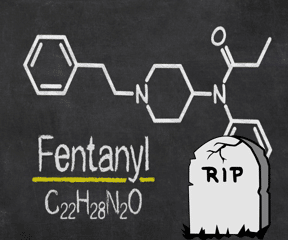Fentanyl is a powerful synthetic opioid similar to morphine, however, it is 50 to 100 times more potent. It is a schedule II prescription drug that is typically used to treat severe pain or to manage pain after surgery. It may also be used to treat patients with chronic pain who are may have developed a tolerance to other opioids. Brand names for fentanyl include Actiq®, Duragesic®, and Sublimaze®. Street names for fentanyl or for fentanyl-laced heroin include Apache, Dance Fever, China Girl, China White, Friend, Murder 8, TNT, Goodfella, Jackpot, Tango and Cash.
How do people use fentanyl?
Fentanyl is often administered via injection, transdermal patch, or in lozenges. However, the fentanyl and fentanyl analogs associated with recent overdoses are typically produced illegally. This non-pharmaceutical fentanyl is sold in the following forms: as a powder; spiked on blotter paper; mixed with or substituted for heroin; or as tablets that mimic other, less potent opioids. People can swallow, snort, or inject fentanyl, or they can put blotter paper in their mouths so that fentanyl is absorbed through the mucous membrane.
How does fentanyl affect the brain?
Like heroin, morphine, and other opioid drugs, fentanyl works by binding to the body’s opioid receptors, which are found in areas of the brain that control pain and emotions. When opioid drugs bind to these receptors, they can drive up dopamine levels in the brain’s reward areas, producing a state of euphoria and relaxation. Fentanyl’s effects resemble those of heroin and include euphoria, drowsiness, nausea, confusion, constipation, sedation, tolerance, addiction, respiratory depression and arrest, unconsciousness, coma, and death.
Key Points to Remember
- Fentanyl is a powerful synthetic opioid analgesic that is similar to morphine but is 50 to 100 times more potent.
- Non-pharmaceutical fentanyl is sold in the following forms: as a powder; spiked on blotter paper; mixed with or substituted for heroin; or as tablets that mimic other, less potent opioids.
- Fentanyl works by binding to the body’s opioid receptors, which are found in areas of the brain that control pain and emotions. Its effects include euphoria, drowsiness, nausea, confusion, constipation, sedation, tolerance, addiction, respiratory depression and arrest, unconsciousness, coma, and death.
- The high potency of fentanyl greatly increases risk of overdose, especially if a person who uses drugs is unaware that a powder or pill contains fentanyl







